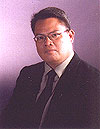|
|
| The miter fits the Indio: The unique destiny of Jorge I. Barlin | ||
|
P.F. Paulix B. Robosa
The Filipinos are admired in Asia by the abundance of their revolutionary heroes. The evolution of 1896-1902, the most vigorous in this part of the globe, resulted in the creation of the first Republic of Asia. That republic, however short lived, is the reason we celebrated the Centennial of the Declaration of the Philippine Independence. More than a hundred years ago we showed to the world that we wanted to be free and paid the price with our countrymen's blood, lives and liberty. The Centennial celebration put forward the events of a century ago that had been instrumental in the creation of the Filipino nation. It brought us Filipinos to a milestone in the road of history where we will be permitted to look at ourselves, to look back and assess the paths we had taken, and look forward to the horizon that awaits us. Also our heroes will be brought to the fore, like a chestful of medals and ribbons, and their deeds and lives revealed and relived. When a nation remembers its great members, it never fails to ask its present citizens to measure their strengths and commitment by the standards set as examples of true service and selfless sacrifice. If our greatest heroes are golden, shining medals, Jorge Imperial Barlin is a mere ribbon.
If I may be so forward, his textbook title, " The First Filipino Bishop " is so uninteresting that at mere mention, one is tempted to think of something else. (Do you find "the first Filipino Printer" or "the first Filipino Dentist" worth looking up?) Not that I underestimate such titles but maybe we Filipinos are not as given to pioneer-worship, as the Americans to their Charles Lindbergh and the Europeans to their Louis Pasteur or there Edmund Hillary1. Some suggest that because he is a Bishop he is more of an ecclesiastical hero better left preserved in the Vatican archives. The only part of his title that seem relevant to us and our history is the word "Filipino". One hundred years ago, The First Filipino Bishop did not have this title nor even entertained the possibility of assuming it. One hundred years ago he was simply Padre Barlin, Vicar Forane of the Province of Sorsogon. At forth-eight, he will play a supporting role to the Philippine revolution in the Bicol region. He saw the events of the year 1898 unfold as the people of Sorsogon became animated as news of the return of Aguinaldo from Hong Kong and the success of his army against the Spaniards slowly filtered in from Albay. Soon bigger news began to come, like in August, the failed Daet uprising and the massacre of the Filipinos involved. This news created fear to both the Spanish and the natives but Padre Barlin remained calmed and reassured everyone. Ten (10) years before, he was appointed by Bishop Herrero of Nueva Caceres as Vicar Forane of the Province and parish priest of the Capital of Sorsogon, placing in Barlin's capable hands the far-off but important province of Sorsogon2. In September, the fire of revolution had reached Naga and the death of many Spaniards greatly affected the Spanish populations of Albay and Sorsogon. A telegram from Governor Bascaran of Albay advised Governor Villamil of Sorsogon to abandon the province for safer places. Not wanting to leave Sorsogon without transferring any form of authority, Governor Villamil turned over his province to the most capable man he could find. To the hands of his Padre Vicareo, he entrusted the government of the Province of Sorsogon. Thus for a time the province of Sorsogon had a churchman for a governor in the person of Padre Barlin.3
|
||
|
|

|

